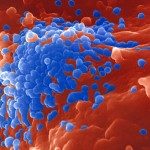Link to Pubmed [PMID] – 12655089
J. Gen. Virol. 2003 Apr;84(Pt 4):885-95
The intrinsic recombination rate of human immunodeficiency virus (HIV) exceeds the point mutation rate by a factor of 10. As the majority of infected cells in vivo harbour multiple proviruses, the stage is set for rampant recombination. Therefore, it may be presumed that phylogenic relationships and mutation frequencies will probably be affected by recombination. However, the proportion of homoplasies arising from recombination and mutation is not known. By studying the evolution of the hypervariable regions of the simian immunodeficiency virus envelope gene among four macaques, it is shown that homoplasies arise more from recombination than from point mutation. When recombination is accounted for, the minimum number of substitutions in a sequence set may be reduced by as much as 45 %. In fact, the true number of point mutations in a set of HIV sequences tends to the number of discrete substitutions. Hence, lineages are younger than anticipated previously, although not in proportion to the ratio of the intrinsic recombination/point mutation rate. Recombination also inflates codon polymorphisms.
